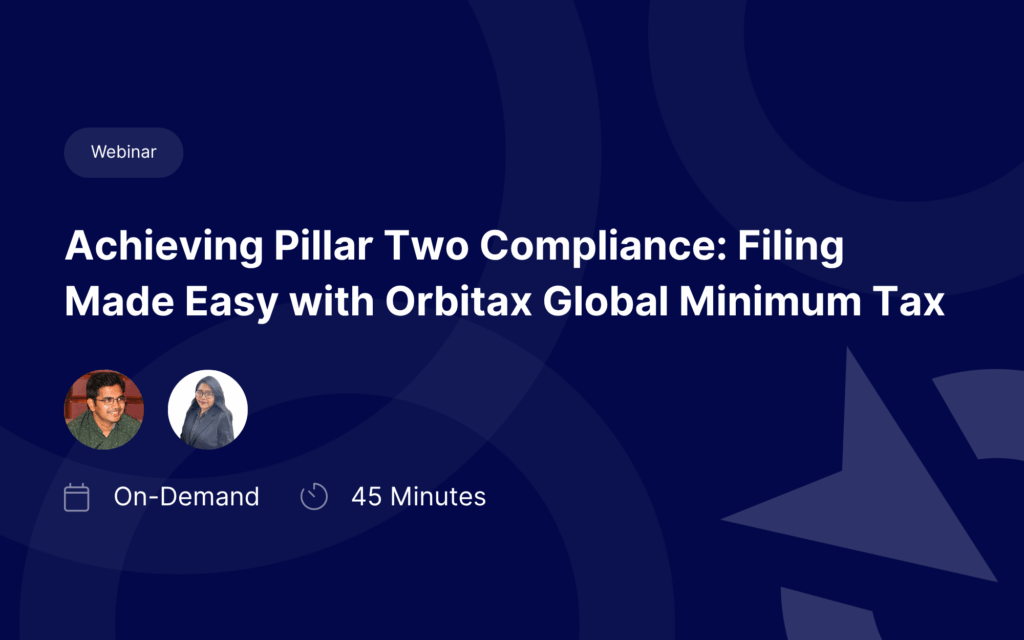Global tax compliance is entering a new era. With Pillar Two now live across more than 57 countries, multinational enterprises (MNEs) are facing unprecedented filing obligations — from registrations and notifications to Qualified Domestic Minimum Top-Up Tax (QDMTT) forms. In a recent webinar with Orbitax experts, we explored how these changes are reshaping compliance processes and what tax teams need to prepare for.
The complexity of Pillar Two filings
One of the major challenges of pillar two filings is the diversity of filing styles across countries. Some jurisdictions, such as Belgium and Japan, have adopted XML-based submissions aligned to OECD schemas. Others, including Ireland and Hungary, rely heavily on web portals and webform-driven inputs. Meanwhile, advanced jurisdictions like the UK and Australia are moving rapidly toward API-based, end-to-end filing. This mix of approaches highlights the urgent need for flexible compliance technology that can support varying jurisdictional requirements.
“
Filing under Pillar Two is not just about completing a form; it’s about adapting to multiple formats, languages, and submission styles that differ from country to country. This is where tax technology becomes critical.
Senior Manager, International Tax
Orbitax
”
Ensuring accuracy in a complex environment
Another recurring theme is the importance of validation. Mistakes in mandatory fields, misapplied calculations, or incomplete financial information can easily derail compliance efforts. Automated validation within Orbitax Filing Manager addresses this challenge by ensuring forms are both complete and accurate before submission. Along with convenience, the goal is reducing risk and maintaining confidence in filings.
Leveraging technology for smarter compliance
Technology is not only keeping pace with jurisdictional demands but actively shaping the compliance landscape. Orbitax Filing Manager provides:
- Library of forms that match each jurisdiction’s filing requirements.
- Automatic sync with GMT Compliance Scenario data.
- Built-in calculator to calculate all formula fields in forms.
- Fillable templates and XML export capabilities, supporting both manual completion and automated workflows.
- Validation checks that flag missing fields or incorrect entries before submission.
Together, these features simplify what would otherwise be a fragmented, manual process.
The role of AI: Introducing XatBot
AI is increasingly central to the future of tax compliance. XatBot, Orbitax’s AI-powered tax assistant fully integrated into the International Tax Platform, is designed to support professionals throughout the compliance journey. Beyond answering technical questions, XatBot assists with practical filing steps like navigating users to complete forms, surfacing relevant rules, and providing smart compliance support.
But its impact goes well beyond filing. As a conversational AI assistant, XatBot enhances research and reference by pulling from Orbitax’s global tax content library, diagnostics and analytics by evaluating Pillar Two exposure and entity structures, and automation by launching workflows, fetching data, or generating audit-ready memos — all through natural language prompts.
Pillar Two compliance is no longer a distant consideration. It is here, and it is reshaping how multinational tax departments operate. Between jurisdictional diversity, complex calculations, and the risk of error, the burden on tax teams is substantial. But with the Orbitax Filing Manager and AI assistance from XatBot, compliance can move from a reactive burden to a structured, controlled process.
To see how, explore Orbitax Pillar Two forms and XatBot. You can also create a free account to try XatBot for free.

